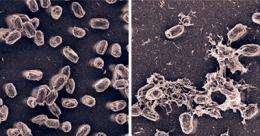Anthrax bacteria conspire with viruses to stay alive

(PhysOrg.com) -- The brute force of Bacillus anthracis, the ancient scourge that causes anthrax, can sweep through and overpower a two-ton animal in under 72 hours. But when it isn't busy claiming livestock and humans throughout the world -- up to 100,000 annually -- it resides ominously in the soil as a spore waiting for its next victim. Researchers at Rockefeller University now reveal that this deadly bacterium isn't the only master of its fate. Its survival is directed and shaped by the DNA of bacteria-infecting viruses in what appears to be an evolutionary contract written to benefit both parties.
The research, led by Vincent A. Fischetti, head of the Laboratory of Bacterial Pathogenesis and Immunology, and Raymond Schuch, a research assistant professor in the lab, revamps the way scientists think about how pathogens exist in the environment in between outbreaks, focusing on the role viruses play during this dormant stage in the life cycle. The implications reach far and wide, from the sequencing of genomes to the recurrent and cyclical nature of disease.
"B. anthracis leads a much more complicated life than we had ever known," says Schuch, whose work will appear in the August issue of PLoS One. "Small, infecting viruses dramatically alter the survival capabilities of B. anthracis. It is more or less a symbiotic relationship in which the interests of both the bacterium and virus are kept in balance."
The secret life of anthrax-causing bacteria emerged from a seemingly innocuous observation made by Louis Pasteur more than 100 years ago. The famous bacteriologist found that earthworms were associated with anthrax-infected animal carcasses in the ground and hypothesized that the earthworm could play an important role in the life cycle of the deadly pest. For the first time, Shuch and Fischetti have now confirmed Pasteur's early hunch. They found that in the gut of the earthworm, B. anthracis infected with a type of virus, known as a bacteriophage, live longer than virus-free bacteria. The gut of the earthworm, they surmised, provides the infected bacteria with a safe niche in which to exist.
The researchers further show that in both the gut of the earthworm and the stark confines of a Petri dish, viruses can alter the lifestyle of B. anthracis in two principal ways. One is associated with the ability to build communities, the state in which bacteria prefer to live in the environment; the other affects the bacterium's ability to produce spores: round, dormant cells with a thick cell wall that enables them to endure harsh environmental conditions that the rod-shaped bacteria cannot. What's more, they found that depending on the conditions of the environment, the virus's DNA manipulates the bacterium's genome to toggle between spore production and community building.
The relationship appears to result from some sort of evolutionary contract that keeps the interests of bacterium and virus in balance. Since viruses cannot infect and grow in spores, they have an interest in silencing genes that ramp up spore production and in activating genes that help build B. anthracis communities. But when soil conditions threaten the survival of anthrax-causing bacteria, spawning a tougher line of defense to weather the soil's extreme conditions benefits both parties. The unveiling of the bacterium's life cycle opens up completely new strategies to combat anthrax infection, says Fischetti.
This isn't the first time that Fischetti and Schuch have seen that bacteriophages can affect the survival of B. anthracis. In 2006 they showed that infected anthrax-causing bacteria become more resistant to a natural antibiotic found in the soil. The new studies now go further, showing how these survival capabilities are not just affected by bacteriophages but actually depend on them.
Bacteriophages, the researchers found, exert their control via molecules known as sigma factors, which delegate proteins to turn specific host genes on or off. Different viruses encode different sigma factors, so the appearance of different traits depends on which virus infects the bacterium. While the DNA of some bacteriophages gets incorporated into the bacterium's single chromosome, the DNA of others exists as separate circular entities called episomes. These episomes can either stay inside one bacterium or flit in and out, infecting several bacteria in a matter of hours.
The finding has implications for the sequencing of genomes. "What that means is that sequencing the genome may not be enough," says Fischetti. "There are more than 1,000 known isolates of anthrax and there is little genetic variation between one isolate and the next. So at face value, it is a really boring genome. But what we see here is that the phage DNA, which works together with the anthrax genome, has always been overlooked."
If bacteriophages can govern the fate of bacteria and bacteria affect human health, the transformation of these bacteria may be able to explain the recurrent and cyclical nature of certain diseases. Humans have 10 times more bacteria on them or in them than the number of human cells, explains Fischetti. And there are 10 times more bacteriophages than there are bacteria. "Bacteriophages play a major role in us and what goes on around us in nature," he says. "I am convinced of that."
More information: PLoS One 4(8): e6532 (August 12, 2009); The secret life of the anthrax agent Bacillus anthracis: Bacteriophage-mediated ecological adaptations; Raymond Schuch and Vincent A. Fischetti
Source: Rockefeller University (news : web)


















